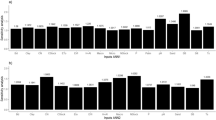Abstract
Soil temperature is a meteorological data directly affecting the formation and development of plants of all kinds. Soil temperatures are usually estimated with various models including the artificial neural networks (ANNs), adaptive neuro-fuzzy inference system (ANFIS), and multiple linear regression (MLR) models. Soil temperatures along with other climate data are recorded by the Turkish State Meteorological Service (MGM) at specific locations all over Turkey. Soil temperatures are commonly measured at 5-, 10-, 20-, 50-, and 100-cm depths below the soil surface. In this study, the soil temperature data in monthly units measured at 261 stations in Turkey having records of at least 20 years were used to develop relevant models. Different input combinations were tested in the ANN and ANFIS models to estimate soil temperatures, and the best combination of significant explanatory variables turns out to be monthly minimum and maximum air temperatures, calendar month number, depth of soil, and monthly precipitation. Next, three standard error terms (mean absolute error (MAE, °C), root mean squared error (RMSE, °C), and determination coefficient (R 2)) were employed to check the reliability of the test data results obtained through the ANN, ANFIS, and MLR models. ANFIS (RMSE 1.99; MAE 1.09; R 2 0.98) is found to outperform both ANN and MLR (RMSE 5.80, 8.89; MAE 1.89, 2.36; R 2 0.93, 0.91) in estimating soil temperature in Turkey.




Similar content being viewed by others
References
Ahmad MF, Rasul G (2008) Prediction of soil temperature by air temperature: a case study for Faisalabad. Pakistan Journal of Meteorology 5(9):19–27
Bilgili M (2010) Prediction of soil temperature using regression and artificial neural network models. Meteorog Atmos Phys 110:59–70
Bilgili M, Sahin B, Sangun L (2013) Estimating soil temperature using neighboring station data via multi-nonlinear regression and artificial neural network models. Environ Monit Assess 185:347–358
Brar GS, Steiner JL, Unger PW, Prihar SS (1992) Modeling sorghum seedling establishment from soil wetness and temperature of drying seed zones. Agron J 84:905–910
Brooks PD, McKnight D, Elder K (2004) Carbon limitation of soil respiration under winter snowpacks: potential feedbacks between growing season and winter carbon fluxes. Glob Chang Biol 11:231–238
Cigizoglu HK (2003) Estimation, forecasting and extrapolation of river flows by artificial neural networks. Hydrol Sci J 48(3):349–361
Citakoglu H (2015) Comparison of artificial intelligence techniques via empirical equations for prediction of solar radiation. Comput Electron Agric 118:28–37
Cobaner M (2011) Evapotranspiration estimation by two different neuro-fuzzy inference systems. J Hydrol 398(3–4):292–302
Cobaner M, Citakoglu H, Kisi O, Haktanir T (2014) Estimation of mean monthly air temperatures in Turkey. Comput Electron Agric 109:71–79
Dawson WC, Wilby R (1998) An artificial neural network approach to rainfall-runoff modelling. Hydrol Sci J 43(1):47–66
Gao Z, Horton R, Wang L, Liu H, Wen J (2008) An improved force restore method for soil temperature prediction. Eur J Soil Sci 59:972–981
García-Suárez AM, Butler CJ (2006) Soil temperatures at Armagh observatory, Northern Ireland, from 1904 to 2002. Int J Climatol 26:1075–1089
George RK (2001) Prediction of soil temperature by using artificial neural networks algorithms. Nonlinear Analysis: Theory, Methods & Applications 47:1737–1748
Grundmann GL, Renault P, Rosso L, Bardin R (1995) Differential effects of soil water content and temperature on nitrification and aeration. Soil Sci Soc Am J 59:1342–1349
Hares MA, Novak MD (1992) Simulation of surface energy balance and soil temperature under strip tillage: I. Model description. Soil Sci Soc Am J 56:22–29
Haykin S (1998) Neural networks—a comprehensive foundation, 2nd edn. Prentice-Hall, Upper Saddle River, pp. 26–32
Helsel DR, Hirsch RM (2002) Statistical methods in water resources, techniques of water-resources investigations of the United States, book 4, hydrologic analysis and interpretation, chapter A3. http://water.usgs.gov/pubs/twri/twri4a3/
Hontoria L, Aguilera J, Zufiria P (2005) An application of the multilayer perceptron: solar radiation maps in Spain. Sol Energy 79(5):523–530
Horton B, Corkrey R (2011) A weighted coefficient model for estimation of Australian daily soil temperature at depths of 5 cm to 100 cm based on air temperature and rainfall. Soil Research 49(4):305–314
Jang JSR (1993) Anfis adaptive-network-based fuzzy inference system. Systems, Man and Cybernetics, IEEE Transactions on 23:665–685
Kang S, Kim S, Oh S, Lee D (2000) Predicting spatial and temporal patterns of soil temperature based on topography, surface cover and air temperature. For Ecol Manag 136:173–184
Karunanithi N, Grenney WJ, Whitley D, Bovee K (1994) Neural networks for river flow prediction. J Comp Civ Eng ASCE 8(2):201–220
Kemp PR, Cornelius JM, Reynolds JF (1992) A simple model for predicting soil temperatures in desert ecosystems. Soil Sci 153:280–287
Kim S, Singh VJ (2014) Modeling daily soil temperature using data driven models and spatial distribution. Theor Appl Climatol 118(3):465–479
Kisi O, Tombul M, Kermani MZ (2015) Modeling soil temperatures at different depths by using three different neural computing techniques. Theor Appl Climatol 121(1):377–387
Kluender RA, Thompson LC, Steigerwald DM (1993) A conceptual model for predicting soil temperatures. Soil Sci 156:10–19
Krishnan A, Rao GGSN (1979) Soil temperature regime in the arid zone of India. Archiv für Meteorologie, Geophysik und Bioklimatologie, Serie B 27(1):15–22
Lin JD (1980) On the force-restore method for prediction of ground surface temperature. Journal of Geophysical Research: Oceans 85(C6):3251–3254
Lippman R (1987) An introduction to computing with neural nets. IEEE ASSP Mag 4:4–22
Mazou E, Alvertos N, Tsiros IX (2012) Soil temperature prediction using time-delay neural networks. In: Helmis CG and Nastos PT (eds) Advances in meteorology, climatology and atmospheric physics. Springer Atmospheric Sciences
McCann IR, McFarland MJ, Witz JA (1991) Near-surface bare soil temperature model for biophysical models. Transactions of American Society of Agricultural and Biological Engineers 34:748–755
MGM (2016) Turkish state meteorological service, www.mgm.gov.tr
Mohandes M, Rehman S, Halawani TO (1998) Estimation of global solar radiation using artificial neural networks. Renew Energy 14(1–4):179–184
Montgomery D, Peck E, Vining G (2001) Introduction to linear regression analysis, 3rd edn. John Wiley, New York
Negnevitsky M (2005) Artificial intelligence: a guide to intelligent systems. Pearson Education Limited, Harlow, Essex CM20 2JE, England
Ozturk M, Salman O, Koc M (2011) Artificial neural network model for estimating 579 the soil temperature. Can J Soil Sci 91:551–562. doi:10.4141/CJSS10073
Paul KI, Polglase PJ, Smethurst PJ, O’Connell AM, Carlyle CJ, Khanna PK (2004) Soil temperature under forests: a simple model for predicting soil temperature under a range of forest types. Agric For Meteorol 121:167–182
Peters-Lidard CD, Blackburn E, Liang X, Wood EF (1998) The effect of soil thermal conductivity parameterization on surface energy fluxes and temperatures. J Atmos Sci 55:1209–1224
Qian B, Gregorich EG, Gameda S, Hopkins DW, Wang XL (2011) Observed soil temperature trends associated with climate change in Canada, Journal of Geophysical Research. Atmosphere 116(D2):1–16
Rao V, Rao H (1996) C++ neural networks and fuzzy logic, B-14. Connaught Place: BPB Publications, New Delhi , pp. 380–381110001
Rehman S, Mohandes M (2008) Artificial neural network estimation of global solar radiation using air temperature and relative humidity. Energy Policy 36(2):571–576
Rounsevell MDA, Bullock P, Haris J (1996) Climate change, soils and sustainability. In: Taylor AG, Gordon JE, Usher MB (eds) Soils and sustainability and the natural heritage. Scottish Natural Heritage. HMSO, London, UK, pp. 121–139
Rumelhart DE, Hinton GE, Williams RJ (1986) Learning internal representation by error propagation. In: Rumelhart DE, McClelland JL (eds) Parallel distributed processing. Foundations, vol 1. MIT Press, Cambridge, MA
Schimel JP, Bilbrough C, Welker JA (2004) Increased snow depth affects microbial activity and nitrogen mineralization in two Arctic tundra communities. Soil Biol Biochem 36:217–227
Seyfried MS, Flerchinger GN, Murdock MD, Hanson CL, Van Vactor S (2001) Long-term soil temperature database, Reynolds Creek experimental watershed, Idaho, United States. Water Resour Res 37:2843–2846
Singh VP (1992) Elementary hydrology, vol 973. Prentice-Hall, Englewood Cliffs, NJ
Siqueira AN, Tiba C, Fraidenraich N (2010) Generation of daily solar irradiation by means of artificial neural networks. Renew Energy 35(11):2406–2414
Sviličić P, Vučetić V, Filić S, Smolić A (2015) Soil temperature regime and vulnerability due to extreme soil temperatures in Croatia. Theor Appl Climatol. doi:10.1007/s00704-015-1558-z
Tabari H, Sabziparvar AA, Ahmadi M (2011) Comparison of artificial neural network and multivariate linear regression methods for estimation of daily soil temperature in an arid region. Meteorog Atmos Phys 110:135–142
Talaee PH (2014) Daily soil temperature modeling using neuro-fuzzy approach. Theor Appl Climatol 118:481–489
Vigil MF, Kissel DE (1995) Rate of nitrogen mineralized from incorporated crop residues as influenced by temperature. Soil Sci Soc Am J 59:1636–1644
Walther GR, Post E, Convey P, Menzel A, Parmesan C, Beebee TCJ, Fromentin JM, Hoegh-Guldberg O, Bairlein F (2002) Ecological responses to recent climate change. Nature 416:389–395
Wu W, Tang XP, Guo NJ, Yang C, Liu HB, Shang YF (2013) Spatiotemporal modeling of monthly soil temperature using artificial neural networks. Theor Appl Climatol 113:481–494
Yilmaz T, Ozbek A, Yilmaz A, Buyukalaca O (2009) Influence of upper layer properties on the ground temperature distribution. J Therm Sci Technol 29:43–51
Yin X, Arp PA (1993) Predicting forest soil temperatures from monthly air temperature and precipitation records. Can J For Res 23:2521–2536
Acknowledgments
The author wishes to thank the General Directorate of Turkish State Meteorological Service for supplying the meteorological data used in the present research.
Author information
Authors and Affiliations
Corresponding author
Rights and permissions
About this article
Cite this article
Citakoglu, H. Comparison of artificial intelligence techniques for prediction of soil temperatures in Turkey. Theor Appl Climatol 130, 545–556 (2017). https://doi.org/10.1007/s00704-016-1914-7
Received:
Accepted:
Published:
Issue Date:
DOI: https://doi.org/10.1007/s00704-016-1914-7




